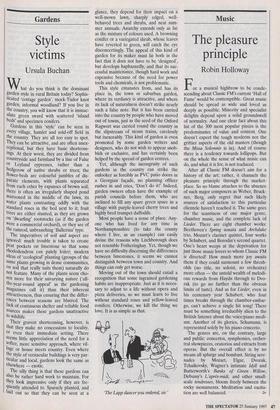Gardens
Style victims
Ursula Buchan
What do you think is the dominant garden style in rural Britain today? Sophis- ticated 'cottage garden', mock-Tudor knot garden, informal woodland? If you live in the country, you will know that it is immac- ulate green sward with scattered 'island beds' and specimen conifers. Gardens in this 'style' can be seen in every village, hamlet and sold-off field in the country. They are all too easy to spot. They can be attractive, and are often unex- ceptional, but they have basic shortcom- ings. At their worst, they are divided from countryside and farmland by a line of False or Leyland cypresses, rather than a hedgerow of native shrubs or trees; the flower-beds are colourful jumbles of dis- parate elements, with plants separated from each other by expanses of brown soil; there is often an irregularly shaped pond marooned in the middle of the lawn, its water plants contrasting oddly with the standard roses in the bed next to it; fruit trees are either stunted, as they are grown on 'dwarfing' rootstocks (as if the garden were a commercial orchard), or they are of the ramrod, unbranching 'Ballerina' type. The imperatives of soil and aspect are ignored: much trouble is taken to create Peat pockets on limestone so that some rhododendron can palely loiter; modern Ideas of 'ecological' planting (groups of the same plants growing in dense communities, on soil that really suits them) naturally do not feature. Many of the plants seem cho- sen more for their unvarying nature (`all- the-year-round appeal' as the gardening magazines call it) than their inherent attractiveness, thus ensuring that the differ- ences between seasons are blurred. The lack of continuous shelter and reliable food sources makes these gardens unattractive to wildlife.
Their gravest shortcoming, however, is that they make no concessions to locality, or even their immediate setting. There seems little appreciation of the need for a softer, more sensitive approach, where vil- lage or house meets country. Even where the style of vernacular buildings is very par- ticular and local, gardens look the same as elsewhere — exotic.
The silly thing is that these gardens can also be rather hard work to maintain. For they look impressive only if they are fre- quently attended to. Sparsely planted, and laid out so that they can be seen at a glance, they depend for their impact on a well-mown lawn, sharply edged, well- behaved trees and shrubs, and neat sum- mer annuals. Anarchy extends only as far as the mixture of colours used. A browning conifer or a variegated shrub, whose leaves have reverted to green, will catch the eye disconcertingly. The appeal of this kind of garden for its maker must lie both in the fact that it does not have to be 'designed', but develops haphazardly, and that its suc- cessful maintenance, though hard work and expensive because of the need for power tools and chemicals, is not problematic.
This style emanates from, and has its place in, the town or suburban garden, where its verdancy is attractive, and where its lack of naturalness doesn't strike nearly such a false note. But it has been carried into the country by people who have moved out of towns, just as the seed of the Oxford Ragwort was carried round the country in the slipstream of steam trains, carelessly but inexorably. This kind of garden is even promoted by some garden writers and designers, who do not wish to appear snob- bish or exclusive, and has certainly been helped by the spread of garden centres.
Yet, although the incongruity of such gardens in the country can strike the onlooker as forcibly as PVC patio doors in a Georgian facade, no planning officer rushes in and cries, 'Don't do it!' Indeed, garden owners often have the example of parish councils before them, who are inclined to fill any spare green space in a village with purple-leaved cherry trees and highly bred trumpet daffodils.
Most people have a sense of place. Any- one who has lived for any time in Northamptonshire (to take the county where I live, as an example) can easily divine the reasons why Litchborough does not resemble Fotheringhay. Yet, though we have no difficulty discerning the differences between limestones, it seems we cannot distinguish between town and country. And things can only get worse.
Moving out of the town should entail a recognition that some ingrained gardening habits are inappropriate. Just as it is neces- sary to adjust to a life without opera and pizza deliveries, so we must learn to live without standard roses and yellow-leaved conifers. Otherwise, we kill the thing we love, It is as simple as that.
The Lapp dancer you ordered, sir.'


































































 Previous page
Previous page